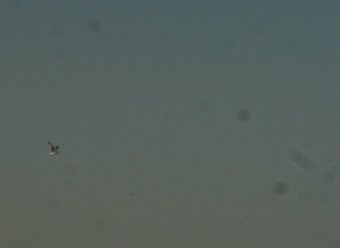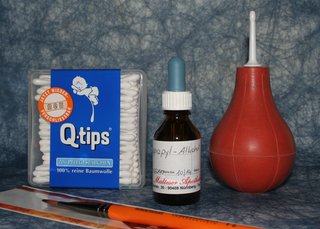

One of the disadvantages of a digital single-lens reflex camera (DSLR) over its analogue predecessor is the dust that accumulates on the sensor over time:

(Picture resized from 900x700 pixels)
I mean the dark stains, not the out-of-focus seagull, of course... Those spots are sensor dust.
The Canon EOS Digital Rebel XT (EOS 350D in Europe) lacks a sensor cleaning function to shake off the dust and recommends to just blow out the dust with a rubber bellow. However, in both cases it often doesn't remove all of the dust. You could go to Canon's repair service to clean the sensor of dogged dust, but it would cost between 50 to 70 € (it's free within the first 6 months, though) and there are reports about varying success. Since I don not want to take the risk paying 70 €, which is ten percent of the price of the camera body, for nothing after all, I was looking for a way to clean it myself.
Of course, self-cleaning means losing the manufacturer guarantee on the filter glass plate which sits on top of the sensor, but I was willing to take that risk. The first things I found were so-called "sensor swabs", which are semi-rigid plastic sticks with the width of the sensor. Some brands just need cleaning liquid, some need to be covered by special wipes that already contain the cleaning liquid. In any case, they are quite expensive -- I've seen 12 swabs for almost 40 €. The available cleaning liquids seem to be either isopropyl alcohol or judging from the list of what's not in there, DI water. Or maybe snake oil? In any case, they cost much more than my favourite scotch... And don't forget the special nylon brush for 50 €.
Pardon me, but this sounds like a first class rip-off to me. I'd spend more than the double amount for the kit (without the brush, that is) than I'd spend for the Canon service. Fortunately, I found these instructions (in German.) And I went to the drug store to buy this:

Don't laugh about the bulb syringe. It was actually much cheaper than a rubber bellow from a photo store. The cotton buds do not necessarily have to be Q-Tips, but brand cosmetic cotton buds have more cotton than no-name ones and only rarely lose fibres. Before you try other buds, check whether the rods are covered well by the cotton even when wet. Otherwise you risk scratching the surface of the sensor filter. Only use cosmetic buds! For the water-colour brush: invest some money. It should not lose any fibres, it should be soft and dense.
For those who don't understand German, the instructions:
The alcohol evaporates quite quickly and some dust has substances attached that doesn't dissolve with alcohol. You may need to use a bud with some DI water after cleaning with isopropyl alcohol in
this case.
Cleaning the sensor with this equipment worked quite well. It took a lot of patience, as I have gas heating and a gas cooker in my flat, which makes the dust in my rooms a bit oily and quite sticky. But apart from one tiny particle in an area where it doesn't hurt I now have a clean sensor.
YMMV, of course, and as I wrote above: if you try it yourself you'll lose the manufacturer warranty on the sensor. If you destroy something, don't blame me or Oliver or anymore else. If you aren't used to handle optical equipment, you'd better go to your camera manufacturers technical service. And don't use cheap cotton buds.
Comments
stickmaker.livejournal.com 18 years, 8 months ago
On a related note, why is it that the people most likely to have dust in their camera are also the people most likely to mistake dust in their camera for a UFO? :-)
Link | Replywoelfisch.livejournal.com 18 years, 8 months ago
Especially as the dust is on every photo taken with a small aperture. :-)
Link | ReplyOn the other hand, I could imagine mistaking a pelican from one of my pictures as a UFO. Or at least as an alien creature... ;-)
New Comment